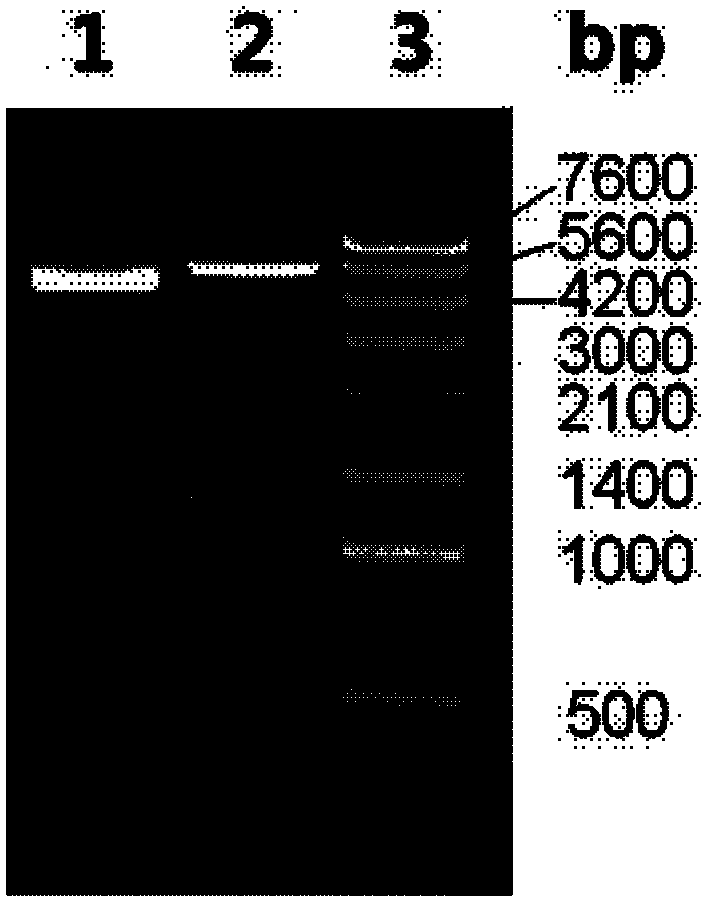IL-17RC-hFc fusion protein and application thereof
A fusion protein and protein technology are applied in the field of fusion proteins of interleukin receptors, which can solve the problems of loss of signal transduction function and lack thereof, and achieve the effects of easy large-scale production, strong controllability and low production cost.
- Summary
- Abstract
- Description
- Claims
- Application Information
AI Technical Summary
Problems solved by technology
Method used
Image
Examples
Embodiment 1
[0027] Example 1 Construction of IL-17RC-hFc recombinant gene prokaryotic expression vector
[0028] Primers were designed according to the gene sequence corresponding to the IL-17RC-hFc fusion protein recombinant fragment (IL-17RC P208-371, IgG1 FcP98-330) and the characteristics of the pET-28a(+) expression vector (see the table below), and were purchased from Invitrogen And the correct pDONR223-IL-17RC ORF cloning plasmid was used as a template, and 3 and 4 were primers, and the PCR amplification of the coding sequence of IL-17RC-hFc protein IL-17RC was carried out ( figure 2 A); the plasmid pCMV6-XL4-IgG1 Fc containing the human IgG1 Fc gene sequence was used as a template (purchased from Origene Company, article number: SC117595), and primers 5 and 6 were used to amplify the human IgG1 Fc segment ( figure 2 B); then use the amplified two sections of PCR product as template, 3 and 6 as primers, carry out overlapping PCR amplification, obtain the gene fragment encoding re...
Embodiment 2
[0032] Example 2 Induced expression of IL-17RC-hFc fusion protein in Escherichia coli
[0033] Transform the recombinant cloning plasmid with correct sequencing into Escherichia coli BL21 (DE3) competent cells, pick a single colony and inoculate it in 10 mL LB medium (containing 50 mg / L kanamycin), culture overnight at 37°C with shaking at 250 rpm. The next day, the overnight culture was transferred to 1000 ml of 2×YT medium (containing 50 mg / L kanamycin) at a ratio of 1:100. When the OD600 was about 0.6, IPTG was added to make the final concentration 0.1 mM, at 30° C., 250 rpm to continue shaking induction culture for 5 hours, then centrifuge at 3000 rpm for 15 minutes, and collect the bacteria. SDS-PAGE and Western-blot analysis were carried out on the precipitate (inclusion body) after bacterial cell lysis, which showed that a large amount of fusion protein could be obtained after being induced by 0.1mM IPTG, see Figure 4 middle lane 5, Figure 6 .
Embodiment 3
[0034] Example 3 Preparation of IL-17RC-hFc fusion protein
[0035] 1. Washing of IL-17RC-hFc inclusion bodies
[0036] Resuspend the bacteria in 40ml of TE buffer [10mmol / L Tris-HCl (pH 8.0), 1mmol / L EDTA] per liter of the induced bacterial solution, lyse the bacteria in an ice bath by ultrasonic for 15min, centrifuge at 4°C and 15000rpm After 10 min, discard the supernatant and collect the precipitate. Wash the precipitate (i.e. the inclusion body) with PBS and 1% Triton X-100 each 20ml once, resuspend the precipitate with 25ml PBS, add 25ml 8M urea dropwise to make the final concentration of urea 4M, keep stirring for 30min, and centrifuge at 15000rpm The precipitate was collected for 30 min. After the precipitate was washed twice with PBS, 4ml of lysis buffer [PBS (pH6.8), 10mmol / L DTT, 1mmol / L EDTA, 2% SDS] was added, and placed in a 4°C refrigerator overnight under magnetic stirring to dissolve the Inclusion bodies after washing. Centrifuge at 12000rpm for 45min at 4...
PUM
 Login to View More
Login to View More Abstract
Description
Claims
Application Information
 Login to View More
Login to View More - R&D
- Intellectual Property
- Life Sciences
- Materials
- Tech Scout
- Unparalleled Data Quality
- Higher Quality Content
- 60% Fewer Hallucinations
Browse by: Latest US Patents, China's latest patents, Technical Efficacy Thesaurus, Application Domain, Technology Topic, Popular Technical Reports.
© 2025 PatSnap. All rights reserved.Legal|Privacy policy|Modern Slavery Act Transparency Statement|Sitemap|About US| Contact US: help@patsnap.com



